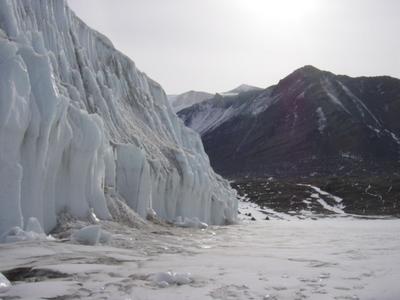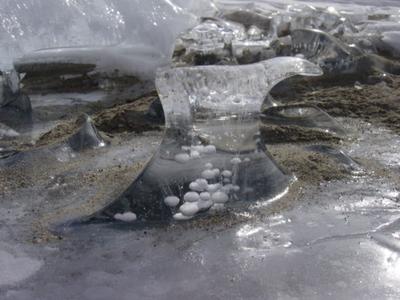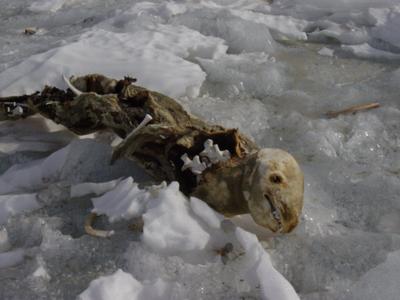18 November, 2003
Seal Hunting!
First thing this morning, we finished melting holes in two locations.
Sensor cables were re-adjusted and data from the storage modules was
successfullydownloaded onto Peter's computer.
After lunch, we collected "glacier berries." Glacier berries are
blocks of ice that have fallen off the glacier. To collect them, we
had to go into one of the many "fall zones" where the glacier wall
towards the top protrudes farther than the wall below and eventually
falls. Walking in an area like this is always a bit risky, so we
collected our "berries" and moved away. These ice blocks, or
berries, create all our water. At each camp, there is a stove with a
giant pot. The berries go in the pot and the stove melts them,
creating fresh, clean water!
Once our berries were collected, we went seal "hunting." We were not
looking for live ones, we wanted dead ones; the older the better!
Although this may sound a bit morbid, there is a scientific reason
for finding the dead seals.
We collected "toe" and "finger" bones to be sent to a professor in
Oregon. The professor intends to date the age of the seals using the
C-14 dating process. C-14 exists in living things and we know it's
rate of decay. By determining the amount of C-14 remaining in the
carcusses, the general date of when that seal was alive on the ice
can be determined.
Peter can then use this information to establish a minimum date of
ice cover for the lake. There is some geo-chemisty analysis of the
lake which suggests that the lake was "ice-free" about two hundred
years ago. If we find a seal on the ice that is older than two
hundred years, we can disprove the geo-chemistry data. Science is
all about gathering evidence to support theories and ideas. The more
evidence that can be collected, the more cross checking of theories
can be done; so these seals will provide important information for
Peter.
We located three very old seals. The distal, or outer, appendages
have some of the best bone for C-14 analysis, so we were after
"finger tips" and "toes." These carcusses were extremely tough; it
took a fair amount of muscle power to remove the desired appendages.
Samples were collected, packaged, and labeled.
Why would seals, and penguins, come into these valleys? No one knows for sure.
Some believe the animals simply get lost and keep moving forward in
hopes of finding ocean, but instead end up deeper into the valley.
At this point, they are about twenty miles from the ocean. Some
believe the animals see the light reflecting off the glaciers and
think it's the ocean, so they head further into the valley. No one
knows why they come, but it is sad to see them here. For a seal to
crawl it's way to this point is mind boggling. The terrain is
extremely jagged; they must have rubbed their bellies raw reaching
this point.
We ended the day measuring the ablation rate for the lake. Ablation
is the rate at which surface ice is removed from the lake. We also
refueled the generator and hotsy (glycol heater) so they would run
through the night and continue melting out our cables.
All is well and I'm having the time of my life!

1. Canada Glacier with a few "glacier berries" below.

2. The Fryxell side of the Canada Glacier.

3. Cool ice formation!

4. One that never found the way back to the ocean.

5. I wonder what made it come to the Dry Valleys in the first place.

6. Ending on a more pleasant note!
Contact the TEA in the field at
.
If you cannot connect through your browser, copy the
TEA's e-mail address in the "To:" line of
your favorite e-mail package.
|
